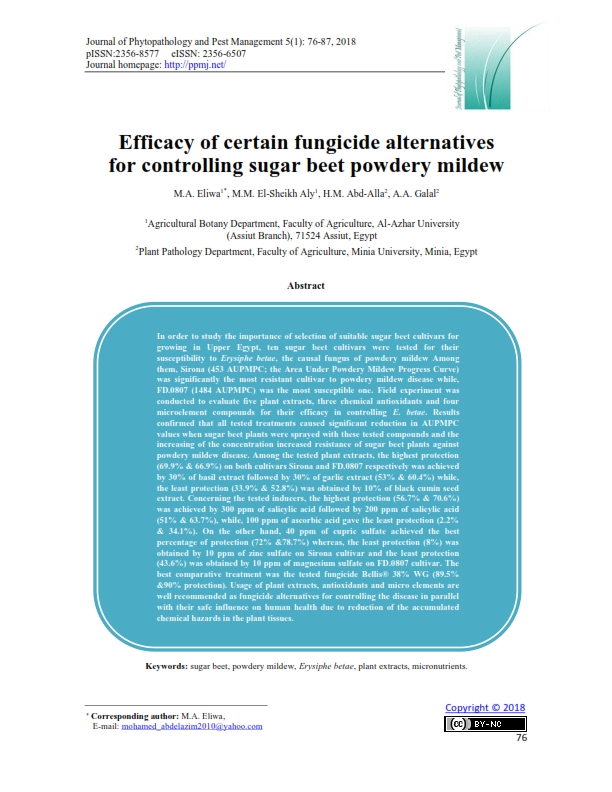Efficacy of certain fungicide alternatives for controlling sugar beet powdery mildew
Keywords:
sugar beet, powdery mildew, Erysiphe betae, plant extracts, micronutrients.Abstract
In order to study the importance of selection of suitable sugar beet cultivars for growing in Upper Egypt, ten sugar beet cultivars were tested for their susceptibility to Erysiphe betae, the causal fungus of powdery mildew Among them, Sirona (453 AUPMPC; the Area Under Powdery Mildew Progress Curve) was significantly the most resistant cultivar to powdery mildew disease while, FD.0807 (1484 AUPMPC) was the most susceptible one. Field experiment was conducted to evaluate five plant extracts, three chemical antioxidants and four microelement compounds for their efficacy in controlling E. betae. Results confirmed that all tested treatments caused significant reduction in AUPMPC values when sugar beet plants were sprayed with these tested compounds and the increasing of the concentration increased resistance of sugar beet plants against powdery mildew disease. Among the tested plant extracts, the highest protection (69.9% & 66.9%) on both cultivars Sirona and FD.0807 respectively was achieved by 30% of basil extract followed by 30% of garlic extract (53% & 60.4%) while, the least protection (33.9% & 52.8%) was obtained by 10% of black cumin seed extract. Concerning the tested inducers, the highest protection (56.7% & 70.6%) was achieved by 300 ppm of salicylic acid followed by 200 ppm of salicylic acid (51% & 63.7%), while, 100 ppm of ascorbic acid gave the least protection (2.2% & 34.1%). On the other hand, 40 ppm of cupric sulfate achieved the best percentage of protection (72% &78.7%) whereas, the least protection (8%) was obtained by 10 ppm of zinc sulfate on Sirona cultivar and the least protection (43.6%) was obtained by 10 ppm of magnesium sulfate on FD.0807 cultivar. The best comparative treatment was the tested fungicide Bellis® 38% WG (89.5% &90% protection). Usage of plant extracts, antioxidants and micro elements are well recommended as fungicide alternatives for controlling the disease in parallel with their safe influence on human health due to reduction of the accumulated chemical hazards in the plant tissues.
Metrics

Published
How to Cite
Issue
Section
License
Authors who publish with Journal of Phytopathology and Disease Management agree to the following terms:
- Authors retain copyright and grant the journal right of first publication with the work simultaneously licensed under a Creative Commons Attribution License that allows others to share the work with an acknowledgement of the work's authorship and initial publication in this journal.
- Authors retain copyright and grant the journal right of first publication with the work simultaneously licensed under the Creative Commons Attribution-Non Commercial License (CC BY-NC). This allows others to share the work with an acknowledgement of the work's authorship and initial publication in this journal.
- Archives of Agricultural Sciences Journal is an Open Access Journal, and articles published are distributed under the terms of the Creative Commons Attribution-Non Commercial License (CC BY-NC). Readers may copy, distribute, and display the work for non commercial purposes with the proper citation of the original work. However, the journal retains the right to exploit subsidiary rights on behalf of the authors.
- Authors are able to enter into separate, additional contractural arrangements for the non-exclusive distribution of the journal's published version of the work (e.g. post it to an institutional repository or publish it in a book), with an acknowledgement of its initial publication in this journal.
- Authors are permitted and encouraged to post their work online (e.g., in institutional repositories or on their website) prior to and during the submission process with full disclosure to the journal, as it can lead to productive exchanges, as well as earlier and greater citation of published work. Following publication in Archives of Agricultural Sciences Journal, the author should update the repository, and include a citation and link to the published work.
Click here for more information on Licensing policy
.png)




